|
There are numerous fierce species of animals in the Mara. One species that at first glance may not appear intimidating is the warthog. They are low to the ground, often crawl around on their front knees and look pretty funny when they run around with their tails pointed skyward. However, there are a lot of animals I would rather bump into than a warthog. For the most part, hyenas do not even attempt to hunt warthogs. Given the chance, they would probably kill a baby warthog, but an adult warthog is usually out of reach. Lions occasionally kill warthogs and for some reason cheetahs will attack warthogs. Cheetahs are pretty feeble compared to the stout hog. I have heard an account of a warthog killing a cheetah. Last summer I even saw a warthog chasing an elephant. I have no idea how this chase started, but when I first saw it the elephant was running and the warthog appeared to be chasing it. After about 10 seconds the warthog veered off the elephant's trail and began chasing an impala. Recently I was fortunate enough to see my first warthog battle. Eye to eye the warriors pushed back and forth,locked in battle. Their deadly tusks only a few centimeters from the their opponent's face. A quick twist of the head capable of delivering a painful blow or cut. 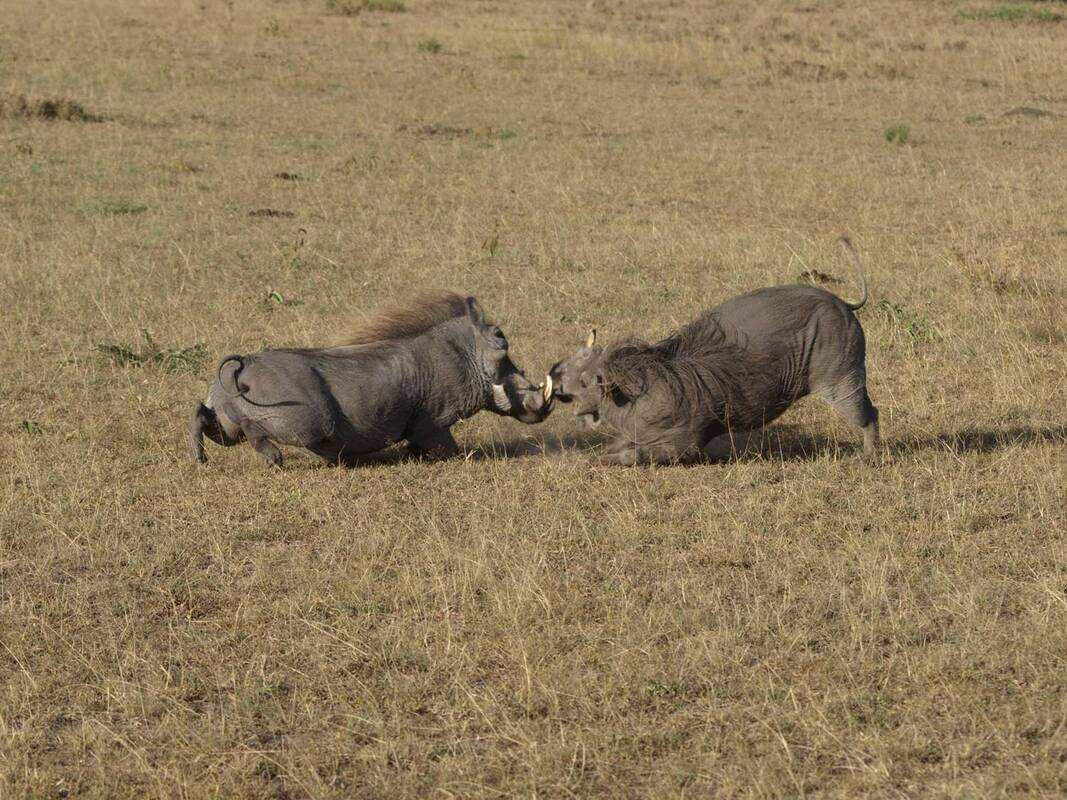 A few minutes of this back and forth action and the battle appeared to be over. Both combatants were bleeding from the snout. Neither was willing to fully retreat, so they both began grazing, with only a meter of grass separating them. I am not sure who won the fight, but I am guessing it was clear to the fighters, otherwise the fight would probably have raged on. Interestingly, deaths resulting from battles between animals of the same species are many times not from the battle itself. Death comes about later because of infection caused by the wounds inflicted or because an injury sustained prevents the animal from getting enough food, water or avoiding predators.
2 Comments
Author: Kenna Lehmann A few weeks ago, just as the migration was starting to show up, the hyenas worked themselves up into a bit of a frenzy for a few days. We had some crazy mornings with 2-3 kills a morning and some massive border patrols. One morning, we were out for our usual morning obs and came across a few hyenas in the morning darkness. We followed them and realized we had our work cut out for us when they joined a group of thirty hyenas. We automatically assumed that they were gearing up for another border patrol. As the sun came up and I mentally prepared myself for a difficult morning of data collection, the hyenas began trailing off in a line in typical border patrol fashion. They crossed the nearby lugga, began social sniffing and pasting all over the place, and then, much to my surprise, crossed the lugga again, went right back to where they had started, and began sacking out. A few hyenas seemed interested in a herd of zebra and some even made a few convincing lunges but, before we knew it, they were all play romping.
Usually play romping is done by cubs at the den so we were pretty surprised to see subadults and adults running around acting like children. The sheer number of hyenas playing was impressive to see. Even our oldest hyena, Navajo, got in on the play time. Author: Andy B. Lately we have been hearing reports of a strange mystery creature roaming the plains near Talek camp. A few days ago I saw this creature for myself and could hardly believe my eyes. This morning I saw it for a second time. There is no mistaking it. We have a genuine mystery creature in our midst. I was able to snap a photo of it as proof.
Okay, so maybe it’s not quite so mysterious. It appears to be, at least mostly, a Thompson’s gazelle. However, there is certainly something strange about it. Its body is shaggier than any other I’ve seen so far, and there’s no mistaking that head. This unique Tommy immediately brings to mind hypertrichosis, or “werewolf syndrome”, in humans, but we’d like to hear what other theories are out there that might explain the strange appearance of this poor Tommy. Author: Kay Holekamp
Camille, who lives in the Conservancy camp year-round, reports that the mongooses showed up at the breakfast table again the very first morning after Dee & I had to drive away to return to Nairobi for Dee’s homeward bound flight. So here’s a glimpse of what Dee missed mongoose-wise. On the other hand, 3 days after Dee left, a hippo died in the forest 50 meters from camp, and the lions and North hyenas have been warring over the carcass day and night ever since. Not only does this mean it’s very scary living in that camp right now due to the constant presence of so many large carnivores, but this also means the whole camp smells absolutely unbelievably terrible, as the hippo carcass is situated directly up wind of camp. As long-time blog readers will recall, however, spotted hyenas can make a hippo carcass vanish very quickly, so it ought to be completely gone in only a couple more days. Hopefully Camille will post a blog entry soon about adventures associated with the dead hippo in camp. 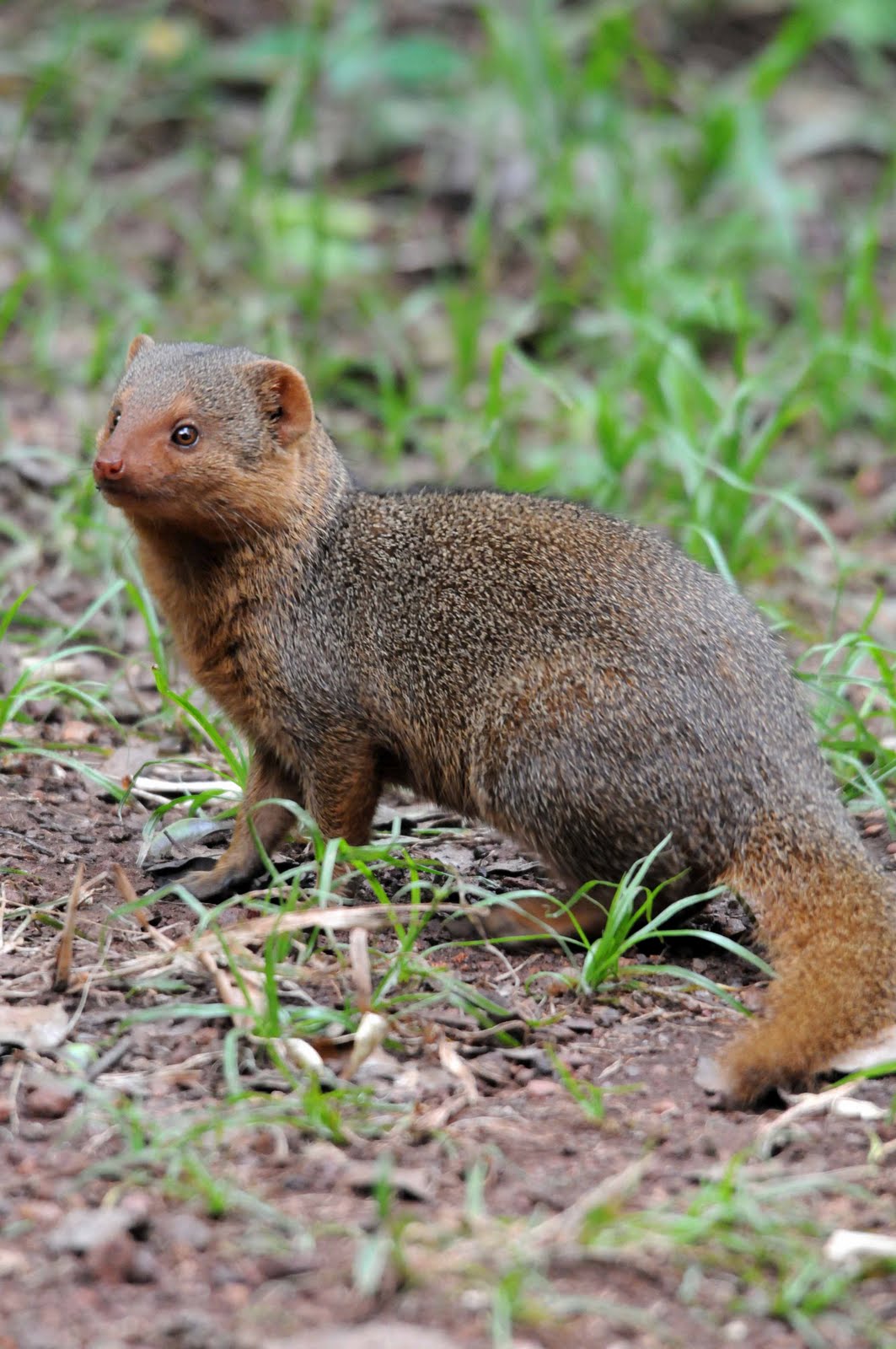 Author: Kay Holekamp
We converted the dollars to Kenya shillings shortly after Dee arrived in Nairobi, and when she got to camp, she handed most of this cash directly to Stephen, who was, I believe, as shocked as he was pleased. He had clearly never expected to be able to replace so many of his lost animals. At my suggestion, Dee held back a little bit of the money she and her friends had donated, and we are using those funds to buy some cyclone fencing and other materials necessary to make Stephen’s shoat corral predator-proof so such carnage can’t happen again in future. Stephen can’t read or write to thank you all himself, so I’m doing that for him here. When Dee handed him that money, she showed him photos of all her friends back in the States who had contributed to the “shoat disaster relief fund.”
Since then, Stephen has expressed his appreciation several different times in various ways, most immediately by inviting Dee to a goat roast at his manyatta (she gracefully declined), but also later asking me repeatedly to be sure to express his own appreciation for this generous gift, and the appreciation of his wives and children as well. So to Dee, Maggie, Judy, Carol, Mary Lou, Pook, Greg, Anne, and all the rest of you, “Asante sana!” from Stephen. Wiline Pangle is an alumnus of the Holekamp Lab where she received her PhD in 2008. While living in Kenya, she collaborated on a topi sexual deception study published in the July issue of The American Naturalist journal and featured in an article this week in USA Today.
Author: Mike
The Notes From Kenya blog is about to hit several milestones: two years of blogging and 200 posts. This is a perfect time to reflect on the success and gather some feedback (and have a friendly little competition among bloggers past and present). There have been some remarkable stories shared here and we'd like your input as to which ones indeed are the best. Yes, we can look at the Google Analytics data and see that we've had 44,000 visits from people in 154 countries. That same data shows Kay's Birth Through A Soda Straw post was the most popular. This was followed closely by Kate's Mythbusters and Thrill of the Hunt and then Kay's very first post Lion-Hyena Fight. Yet, as with many things, the numbers don't always give the entire story. Other media coverage, press releases, search engine optimization and external forces sometimes skew these numbers. For example, Kate's Crazy Things Guys Do For Girls was a big hit on Facebook; Kenna's Necropsies grossed many people out; Andy's Jingle Bells offered a twist on the holiday travel stories; and Leslie's Running in Kenya brought some visitors to the blog who were expecting personal fitness related stories. So to mark the two year anniversary of the blog, we'd like to determine the "Fan Favorite" hyena blog post. To phrase this another way, we are going to conduct a poll. This is where we need your help. Nominate your favorite blog post(s) using the comment space below. We'll collect the nominations and do a poll among the most popular stories. What stories are the most memorable? What stories have you enjoyed the most or passed along to friends? The comment thread is open, so please nominate as many as you like. (And yes, we do expect hyena blogging alumni to enlist their family and friends to vote for their own pieces). Then we'll compile the nominations and put a poll up in a couple weeks. The blog post with the most votes will win. The writer of the Fan Favorite post will receive bragging rights and a pat on the back from Kay (unless the post is by Kay in which case she'll need some acknowledgement from the folks at Fisi Camp). If you need help finding a post, use the search box or keywords listed on the left. There are plenty of great stories from the bloggers, so have at it friends and let us know what you like the best. We'd love to hear from all of our readers, so please post your comments. Thank you! Author: Kenna Lehmann A recent blog reader asked us what sacking out is. I really should have known to explain this in my blogs because "sacked out" was one of those terms that everyone used when I got here that left me clueless. It took me a few days of really paying attention to know what "sacking out" was referring to. Sacking out is, most simply, when a hyena is laying down. In our data collection and notes we use this term to describe any hyena that is laying down in a variety of positions. A sacked out hyena can be either a curse or a blessing. At times, it can be a relief to come upon a sacked out hyena. This is partly because it is easy to record in the notes and partly because it allows you plenty of time to ID the hyena without it wandering into bushes or tall grass or a lugga. Other times, a sacked out hyena is the cause of much frustration and teeth gnashing. Some hyenas love to sack out in a way that gives you no hope of identifying the hyena by spots. Here are a few hyena sacking out strategies: Author: Kay Holekamp In our research camp in the eastern Mara we have two night watchmen, or “askaris” in Kiswahili. Their names are Stephen and Lusingo, and they both hail from manyattas across the river from our camp. Last night disaster struck at Stephen’s manyatta, resulting in what can only be described as a catastrophic loss of livestock.
Sometime between midnight and 1 am, a leopard climbed over the 8-foot wall of one of the livestock corral’s in Stephen's manyatta, grabbed a goat, and fled back over the wall. (This morning Stephen found the leopard asleep on a high tree-branch beside the river, with Stephen's goat --now dead, of course-- tucked into a fork in the tree.) Perhaps detecting the scent of blood from the leopard attack, a spotted hyena then approached Stephen’s manyatta, and forced its way into the same livestock corral. The terrified sheep and goats (“shoats”) stampeded and burst out of the corral through a weakly closed gate, and dispersed into the night on the open plain, where they were promptly set upon by a large group of hyenas. Stephen, who was at work guarding our camp at the time, received a call on his cell phone at 1 am telling him the hyenas were mowing down his shoats, so he rushed home. None of the hyena researchers in camp were aware then of what had happened, but this morning Stephen found us and led us to his manyatt, where the scene can only be described as carnage: dead and damaged shoats all over the place, and the surviving shoats huddled together, still apparently terrified. Women and men were trying to salvage what meat they could from the carcasses of the dead ones, and cleaning what was left of the skins. Stephen had tallied the losses, which totaled 50 shoats, each valued at roughly 3000 Kenya shillings ($45.00 US). We have no funds for any sort of compensation scheme here, so all we could do today was to buy several kilos of shoat meat at filet mignon prices to help Stephen recoup some of his losses. This is one of those situations where, despite the fact that the killer hyenas were not among the ones we study, nor did we have anything to do with this awful event, the hyena researchers feel absolutely terrible for Stephen and his family, as this represents a huge financial loss. We will now do whatever we can to help them cope with this disaster, including strengthening their corrals to keep out marauding predators in the future. Author: Andy Gersick This is Andy Gersick. I’m here to study vocal communication and I’m planning a post on that topic soon – hopefully with good clips of hyena calls for readers to click on – but for now I want to talk about some ongoing intrigue in the South clan. The hyena you’re looking at – the one who looks like his head was run over by a lawnmower – is Dolittle. He’s our ranking male in South clan and normally he is as cocky and content as a male hyena can be (which is to say he’s skittish and timid around females but demands respect from the other males). We were frankly stunned when we saw him the other day in North-clan territory with wounds all over his head and neck. We never expect to see members of one clan deep in another’s territory unless they’re immigrant males trying to disperse. As a top male in South, Dolittle shouldn’t have been planning a move. Hanging out in alien-clan territory is a good way to get yourself attacked, so our first thought was that Dolittle must have somehow wandered into North and gotten a beating for it. Now we’re not so sure. Just a couple of weeks earlier we had watched Dolittle behaving like an alpha male in his prime. He was at Orchid Den with Grimace – an unlucky female who’s often in heat but hasn’t managed to produce a viable litter (as far as we know). Apparently Grimace is smelling sexy again, because Dolittle was circling around her with the intense-but-worried interest that typifies a courting male – he would hover as close as possible whenever she sacked out and would follow her in nervous spirals whenever she’d wander, backing off timidly if she looked the least bit annoyed. Every once in awhile, when Dolittle’s spirals took him too far away, Grimace would stop and look over her shoulder at him, almost encouraging him to stop sniveling and catch up. Females aren’t usually inclined to tolerate a male’s presence, much less push him to get closer, so Grimace’s come-hither looks were our best clue that she might be interested in mating. At any rate, Grimace eventually seemed to give up on her anxious suitor and lay down by the den for a real snooze, with Dolittle standing twitchily nearby. At that point, we spotted three other clan males approaching in the tall grass just beyond the den clearing. Dolittle saw them too, and his posture changed completely. He stood up straight and stared intently in their direction, pawing the ground and seeming to send a clear message: Back off. The other changed course to avoid the den and slunk past without even shooting a glance at Grimace. Dolittle was flexing his alpha-male muscles. The animal who showed up in North Territory a few days later was a shadow of that Dolittle. We found him lying in the middle of the road, wounded, exhausted and thin. We decided to hang out and see what would happen to him – half out of scientific interest, half out of worry that the first North animal that saw him would finish him off. But over the next two hours a procession of North-clan hyenas wandered past Dolittle during their morning perambulations, and none of them seemed terribly concerned with the invader. High-ranked Joni gave him an idle sniff – he answered with an intensely submissive posture and she went on her way, trailing young Hooker who barely looked at Dolittle. Later a mixed-sex group of young adults – Leprechaun (m), Arrow (f) and Peepers (f) – thought he was interesting enough to check out from a distance of about 30 meters. Dolittle heaved himself up from his convalescent nap and trotted another 20 meters away, and the three North-ers headed casually in the opposite direction. So now we have a mystery: who or what attacked Dolittle, how did he end up so far from home, and why don’t any of the North animals seem to care? Our best guess at the moment is that North is actually Dolittle’s natal clan, and that whatever happened to get him those injuries sent him back to his childhood home to recover. When young males mature sexually and disperse, their first try is often a failure; when they get tired of being abused in their adoptive clans they often come back home to resume their birth-ranks, get a break from being picked on, and fatten up before making the next attempt. Dolittle is too old to fit this model exactly, and his dispersal to South has been a success up to now, but if he was born in North it may still feel like the safest place to get over a serious trauma. If Dolittle is a North animal, that would explain the tolerant treatment he seems to be receiving from other North-ers. Even if we’re right about that part of it, we still don’t know who gave Dolittle such a thrashing. One possibility is that there has been a mutiny among the South males. If they rose up to depose him, they may have driven him out of South entirely. Audrey DeRose-Wilson recalls a similar event with Rogue, a former number-one male in the Prozac clan. Rogue’s tenure ended suddenly when something triggered an uprising by the other clan males. They turned on him as a group, viciously attacked him and left him severely injured. He loitered around the outskirts of Prozac territory for a few days, then disappeared. He was never seen again. But Dolittle’s injuries may have nothing to do with hyenas – other lab members have speculated that he might have taken a drink at the wrong time and barely escaped from a croc (his wounds don’t look consistent with a lion attack), or even gotten some kind of chemical burn. Two days ago I saw Dolittle a second time, still in North Territory (pictures below). His wounds are healing but he is gaunt and limping badly. The fact that he continues hanging around in North makes me feel more convinced that whatever happened to him happened in South territory. But for now there’s not much we can do to clarify the story. We can only wait to see if Dolittle turns up back in South to resume his reign, or disappears like Rogue.
If you’ve got a theory about what might have happened to Dolittle, post a comment. |
About
Notes From Kenya is a blog run by the students in the Holekamp Lab at Michigan State University, College of Natural Science, East Lansing, Michigan, U.S.A. Archives
July 2020
Categories |
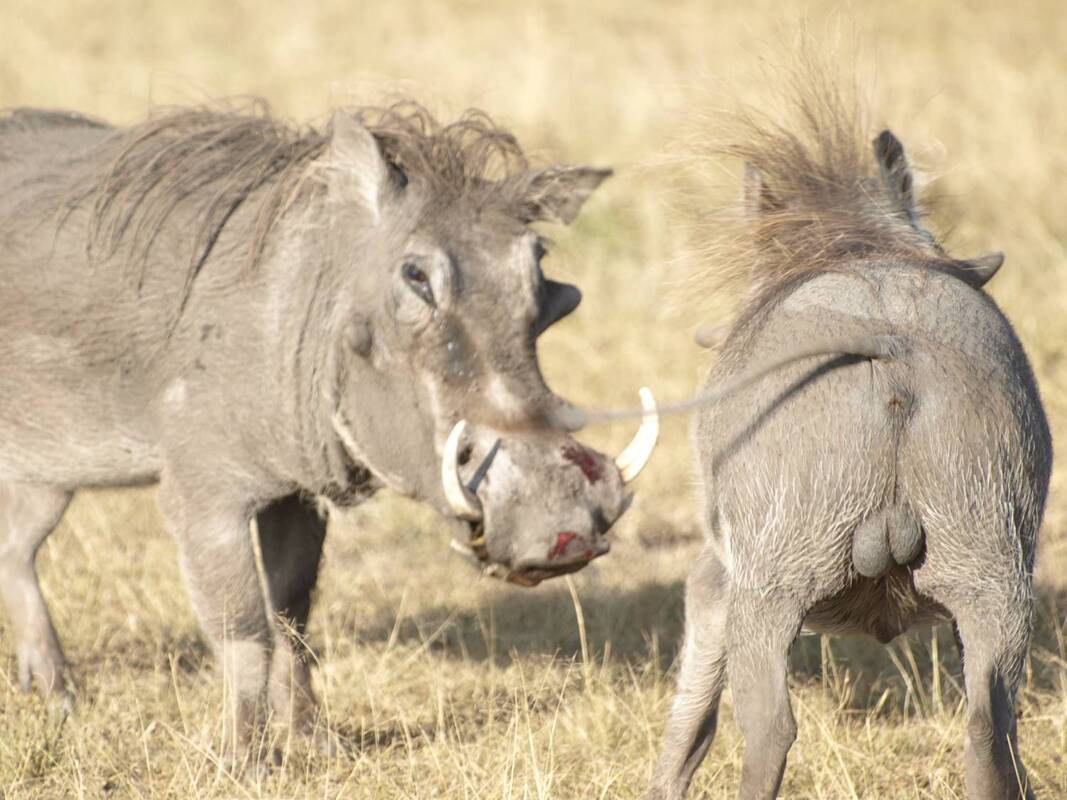
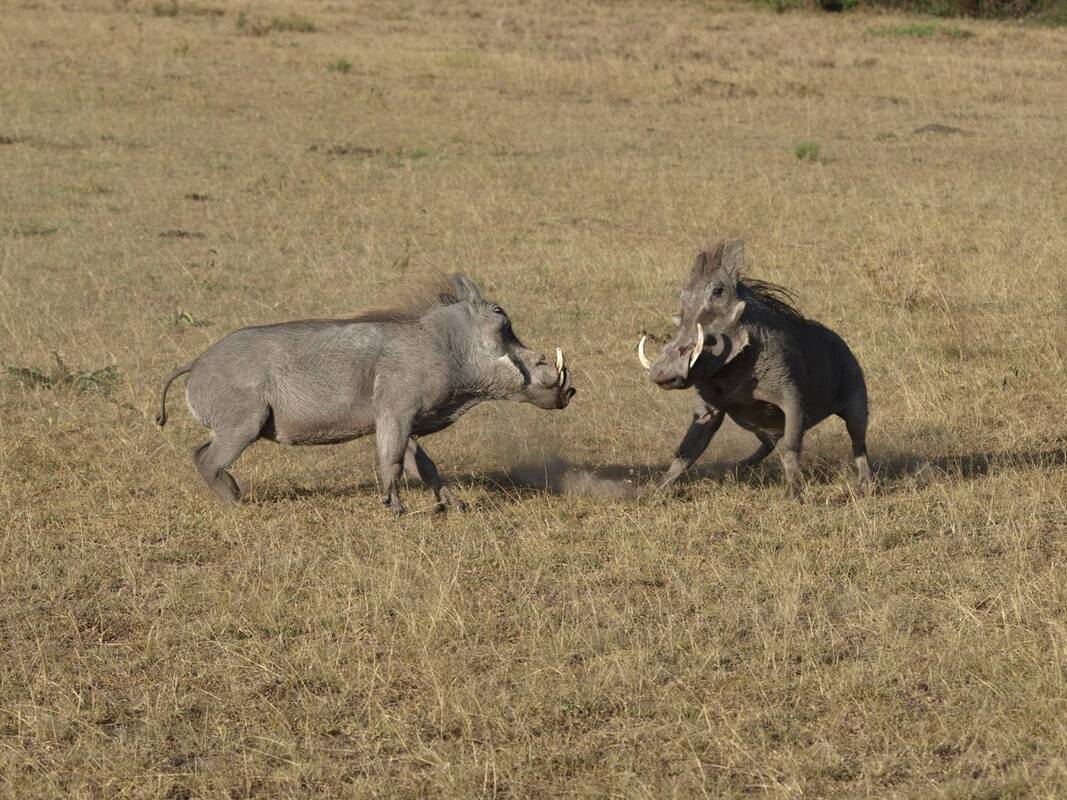
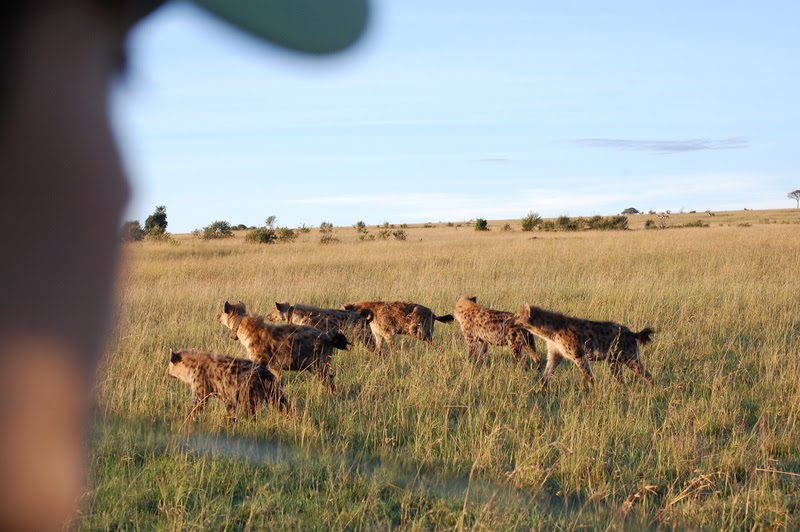
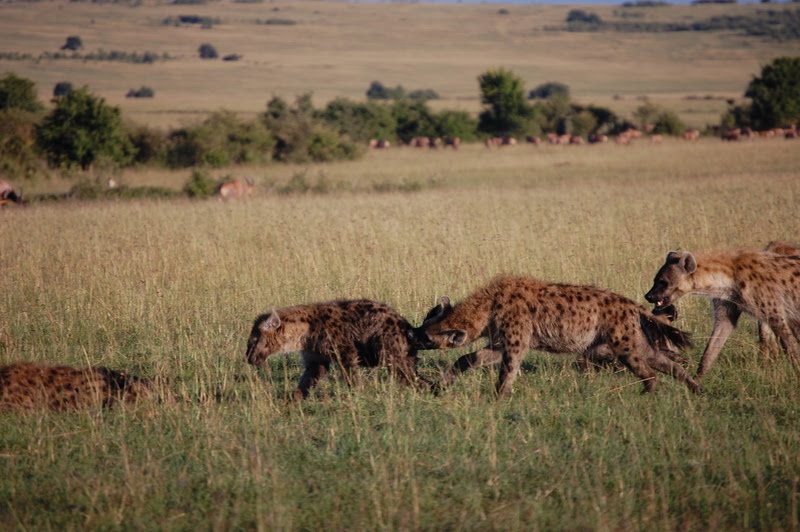
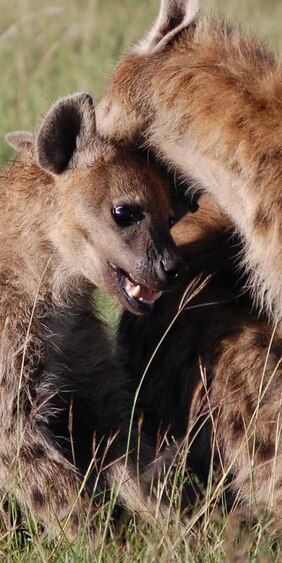
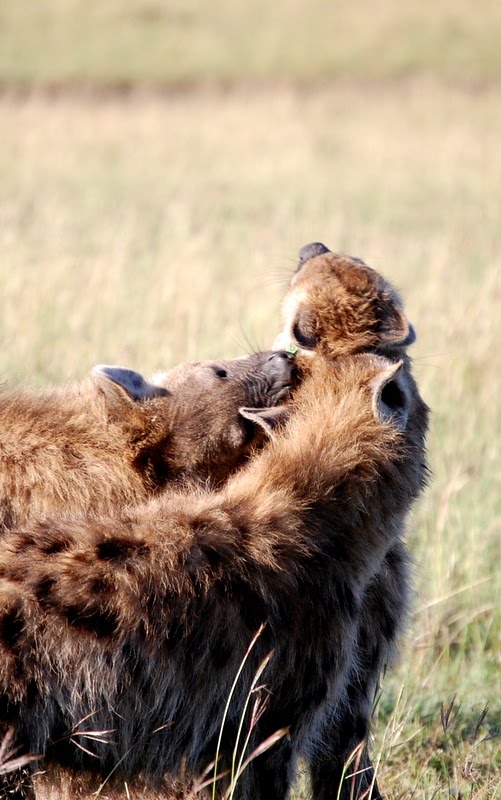
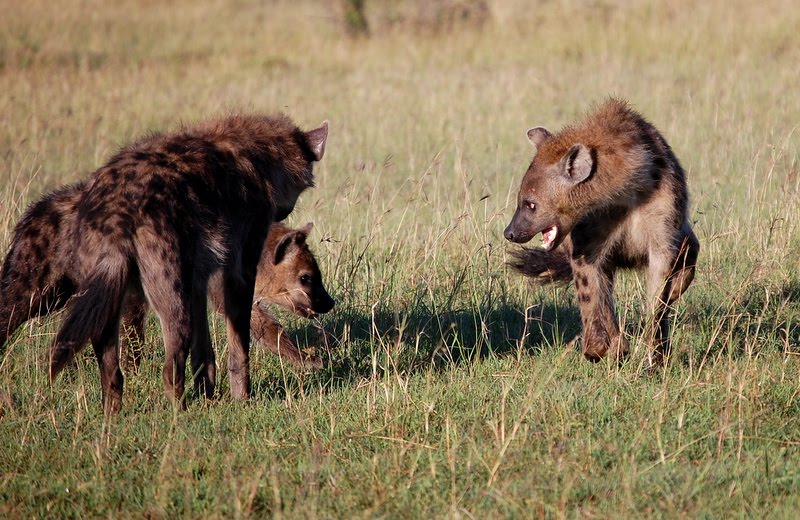
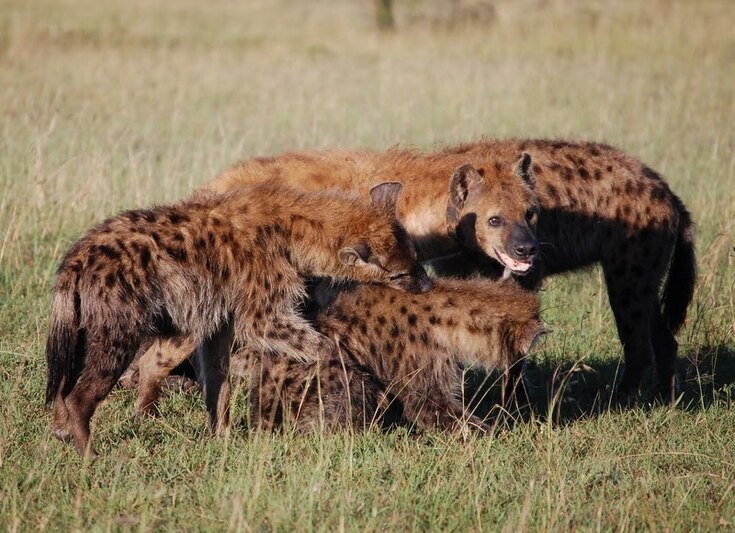
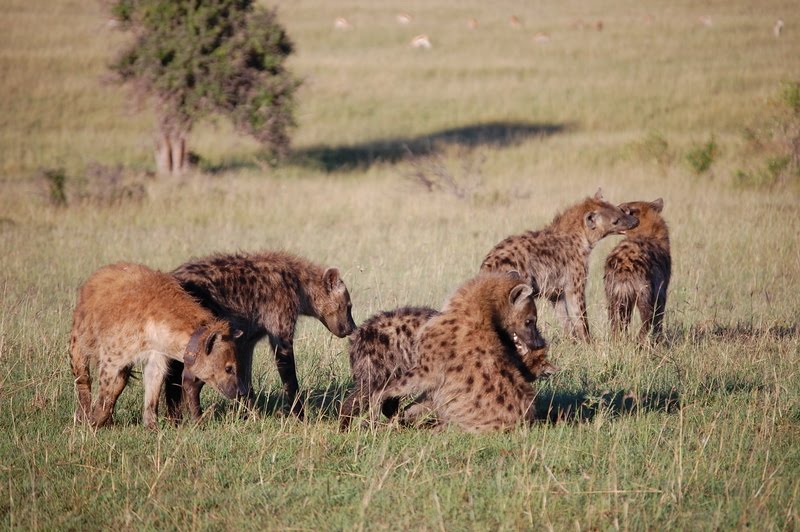
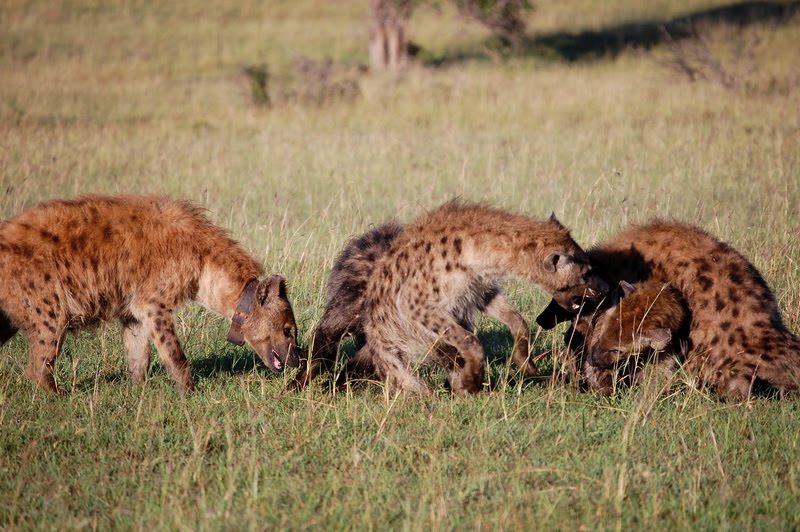
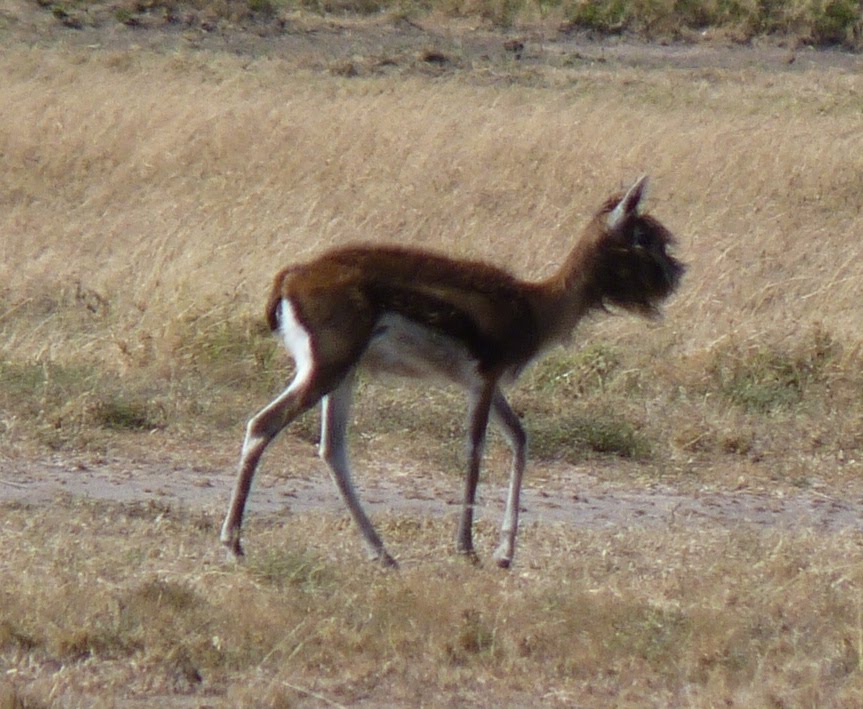
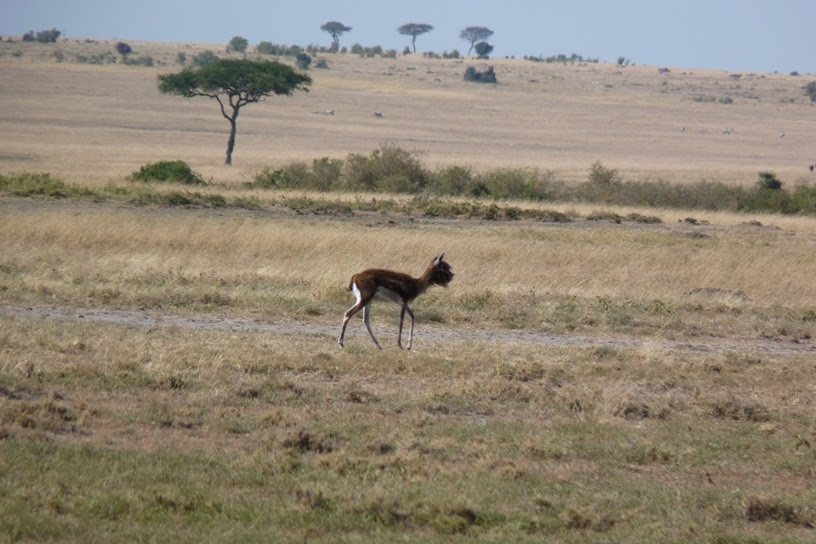
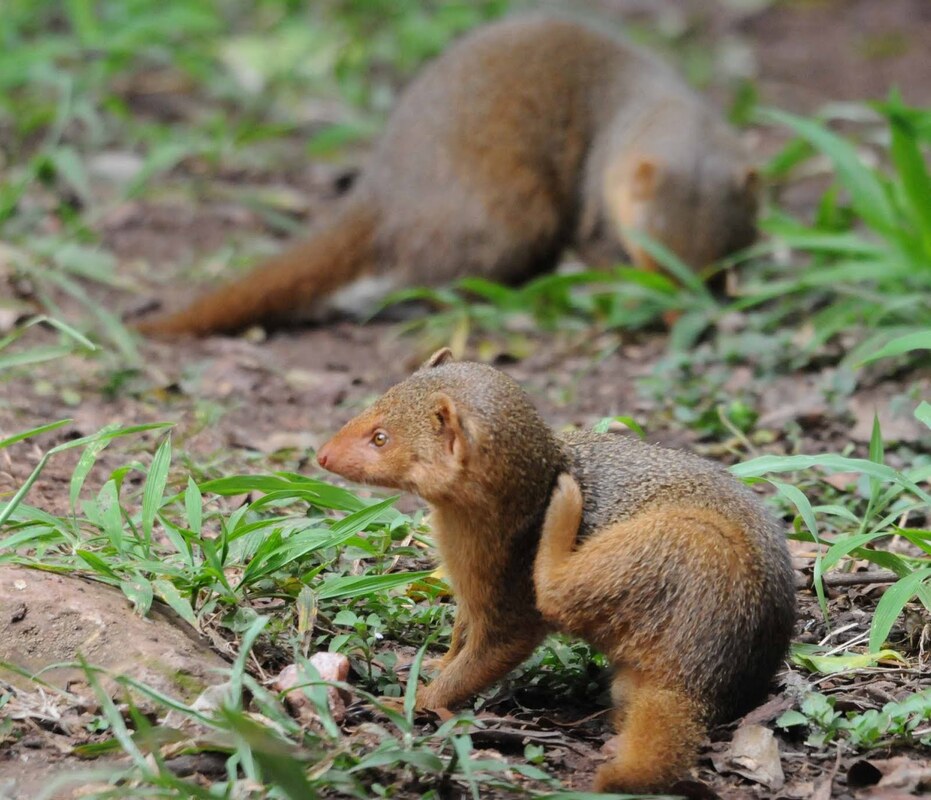
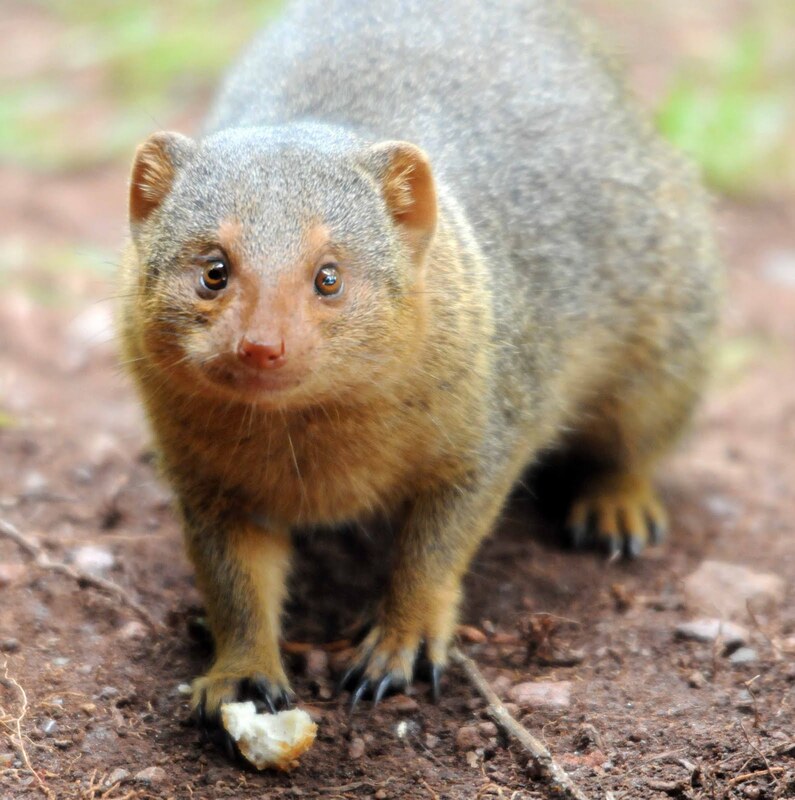
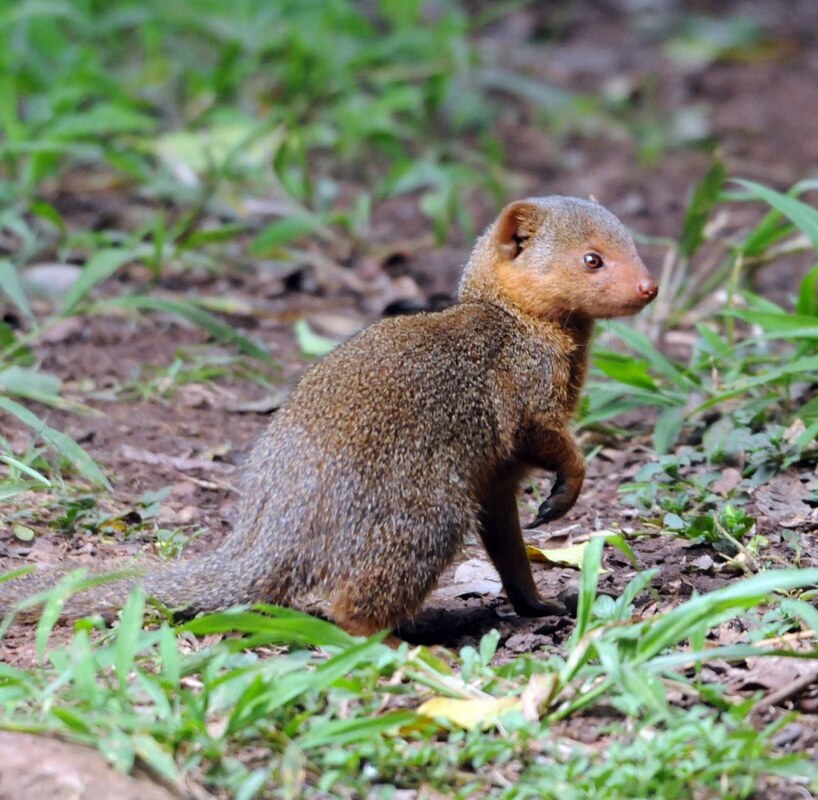
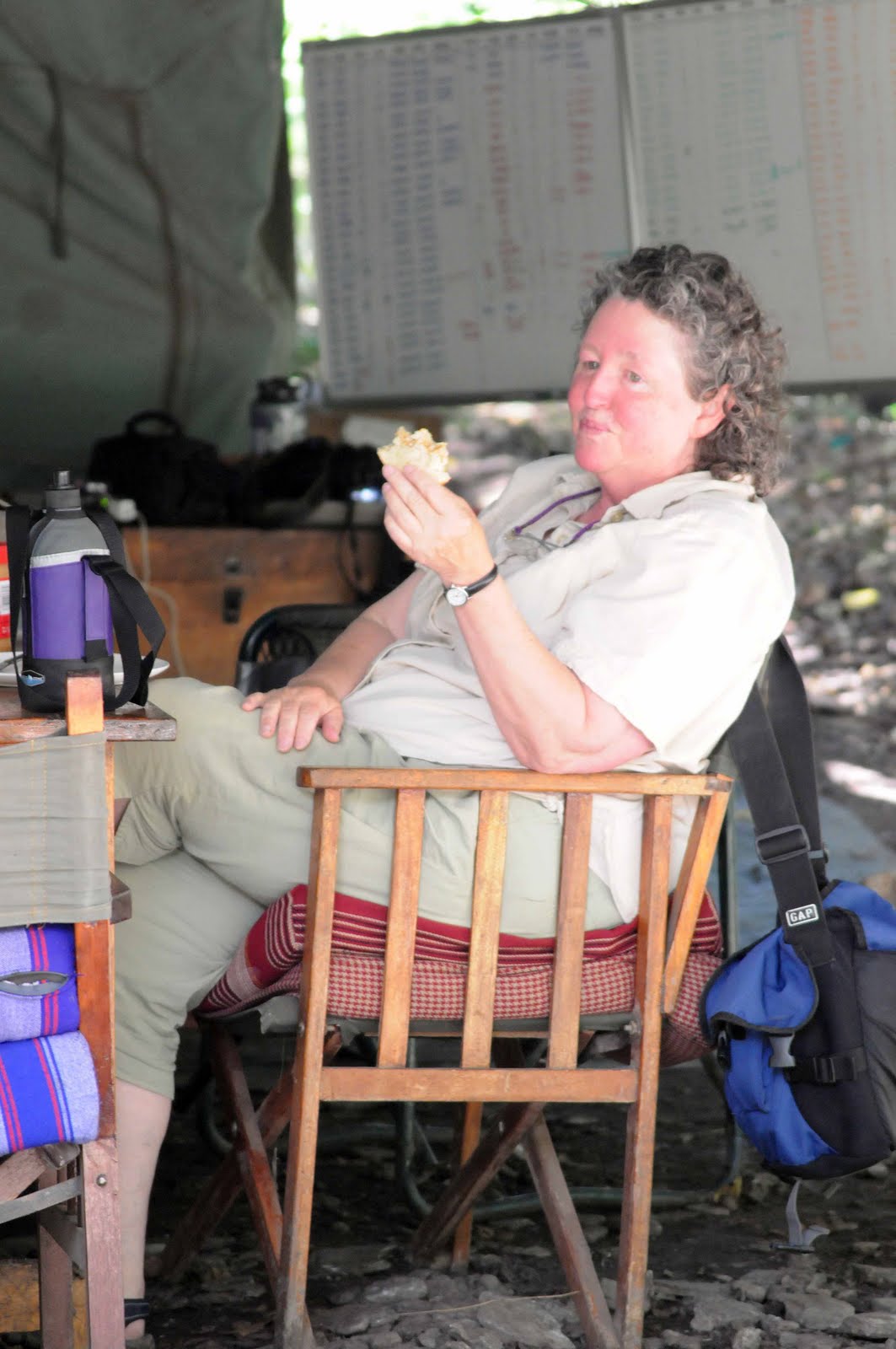
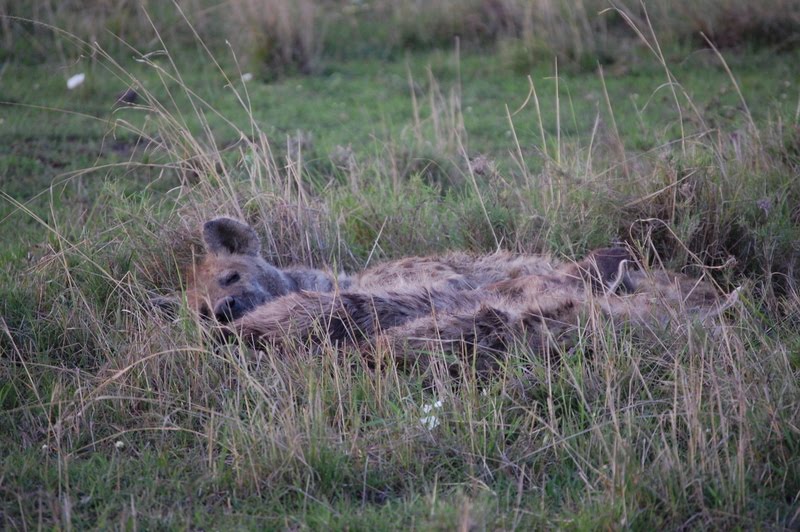
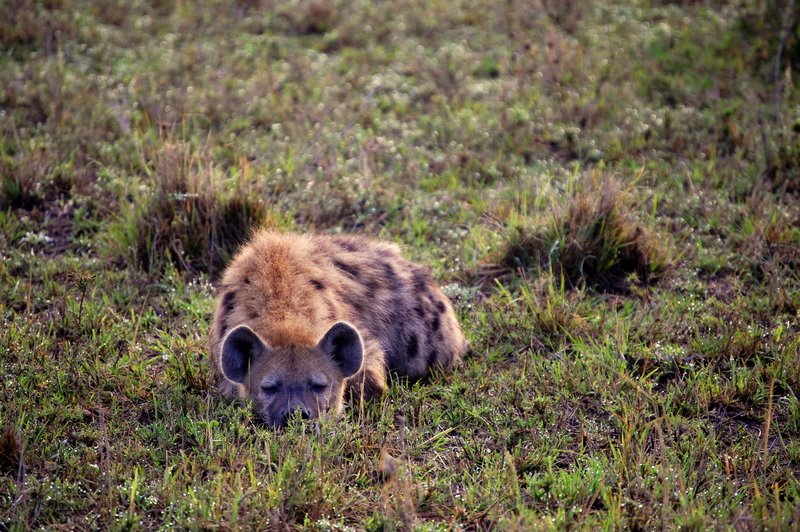
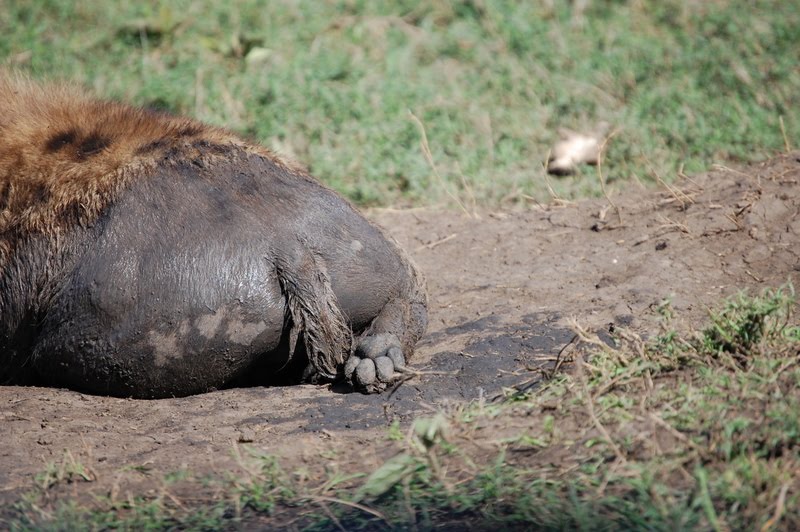
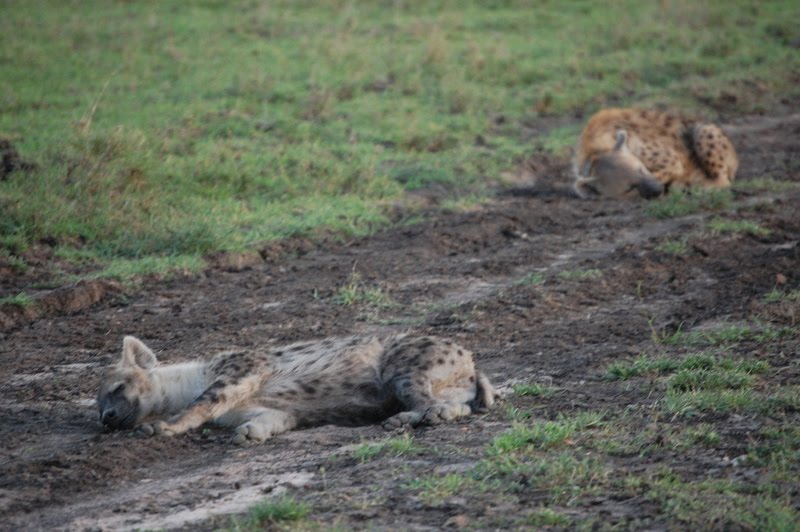
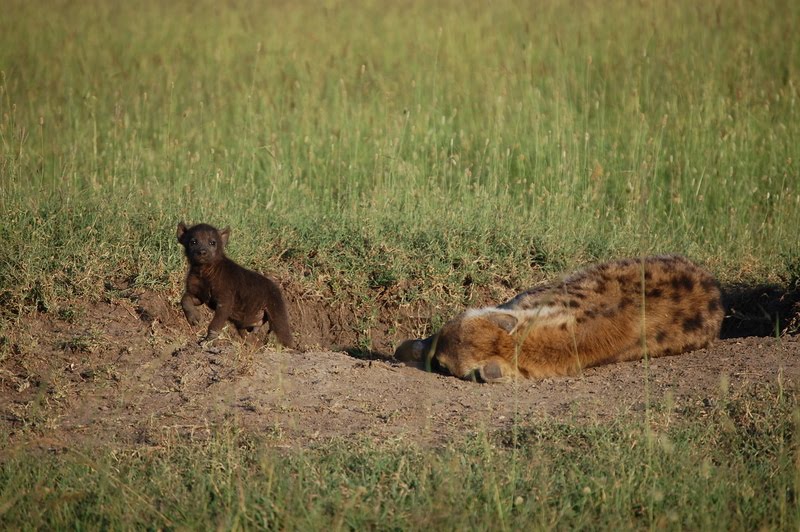
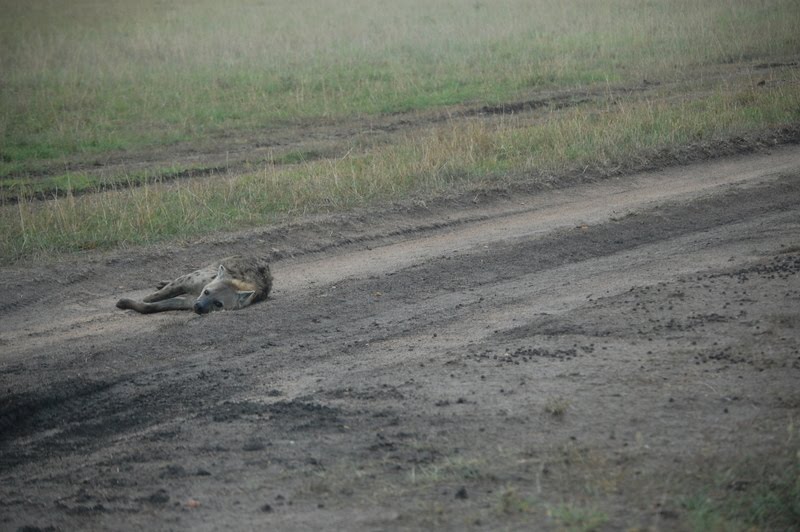
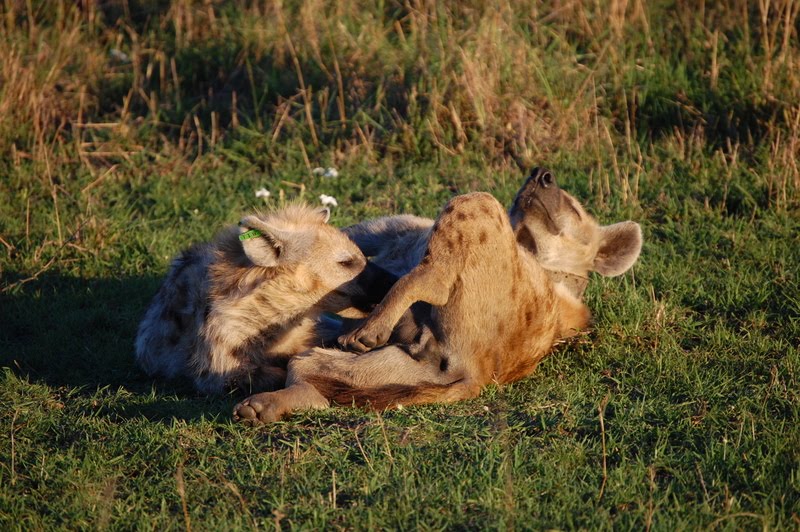
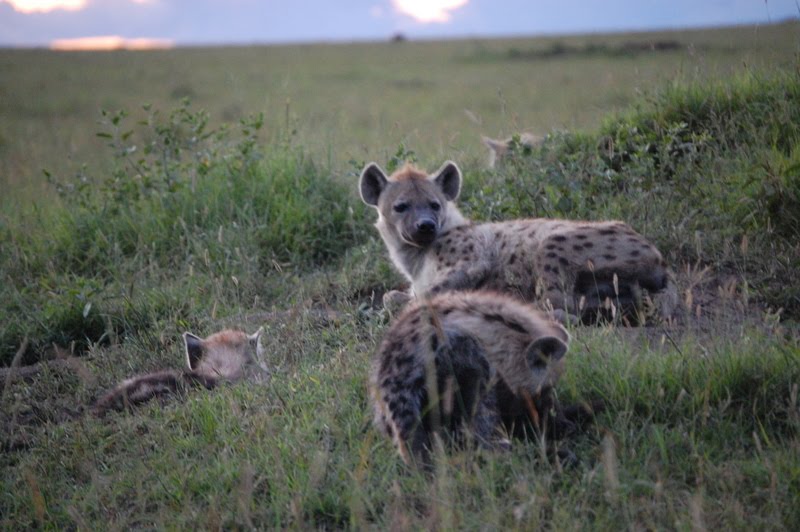
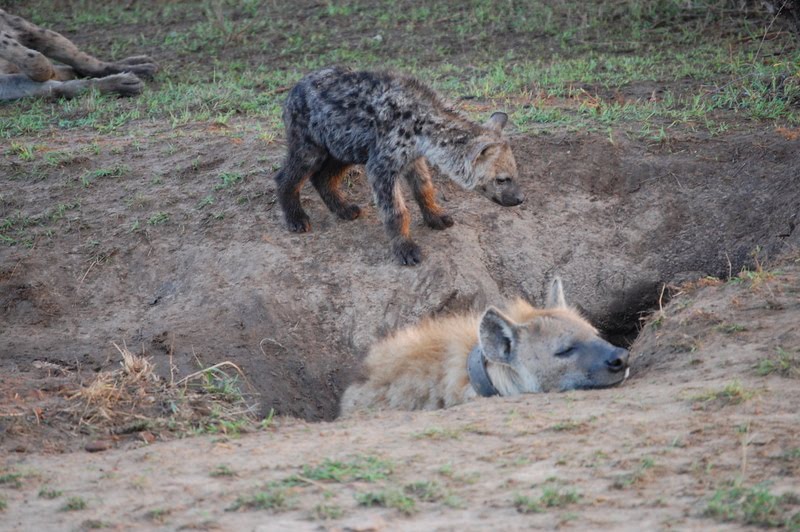
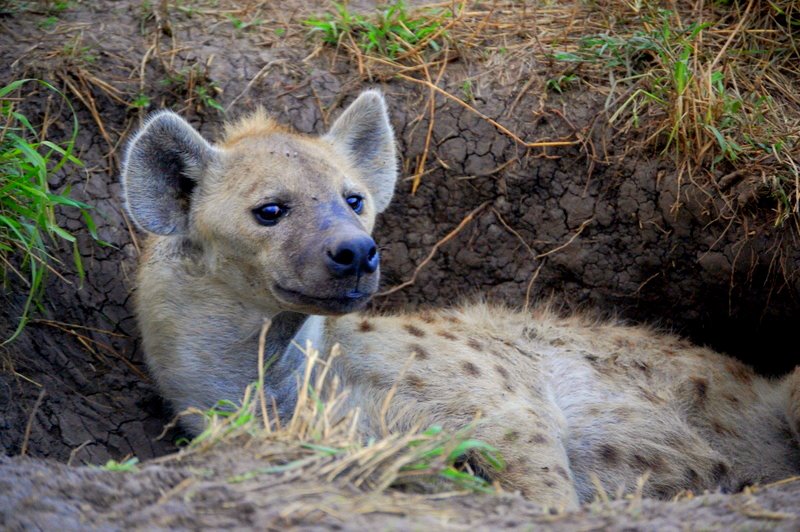
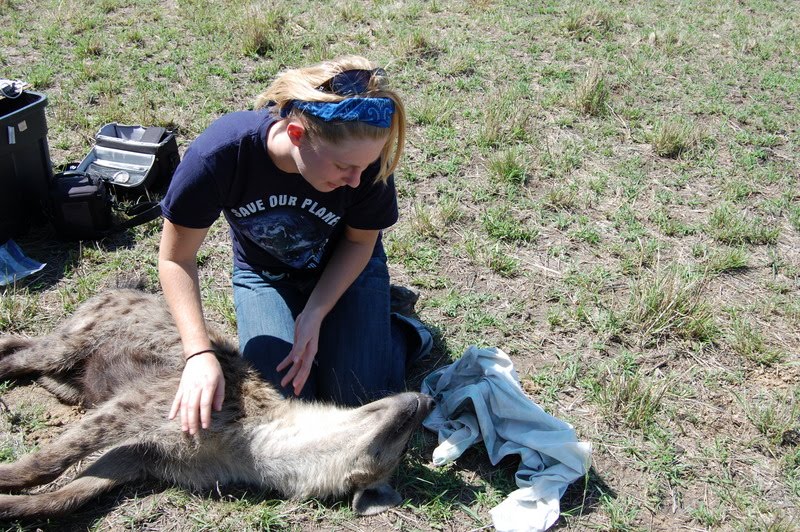
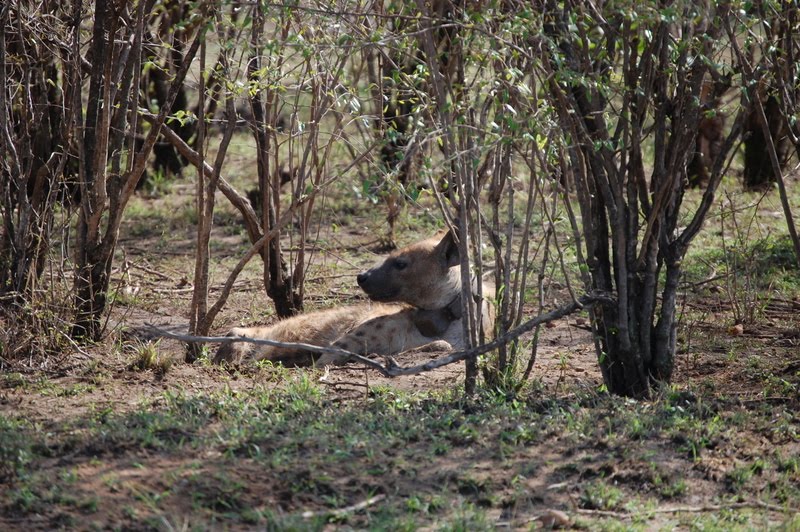
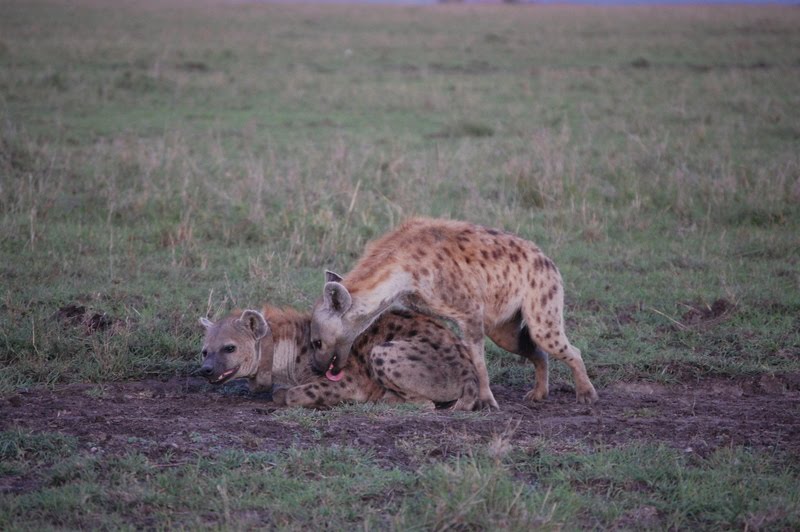
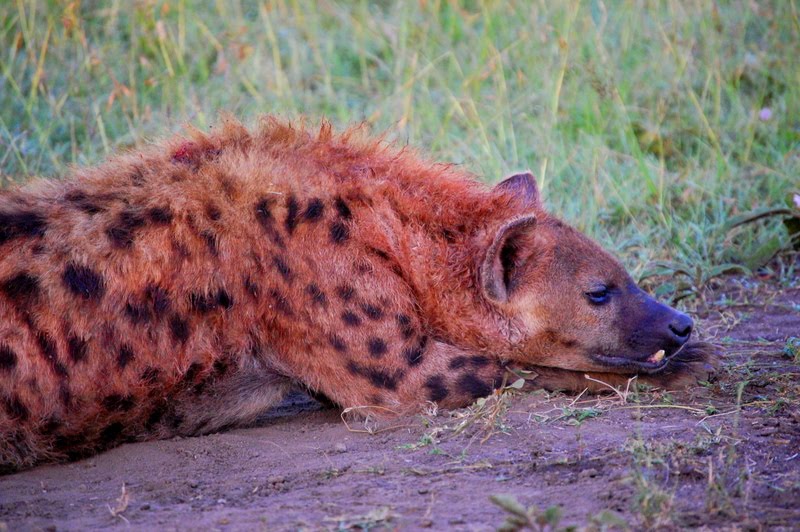
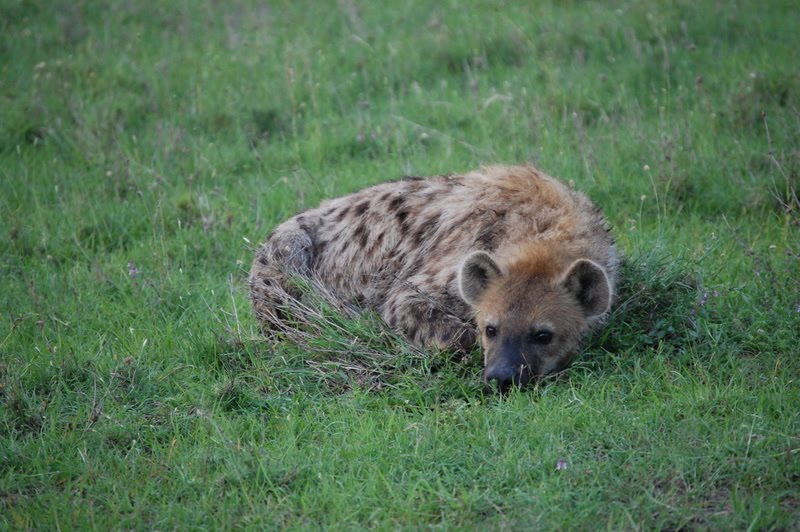
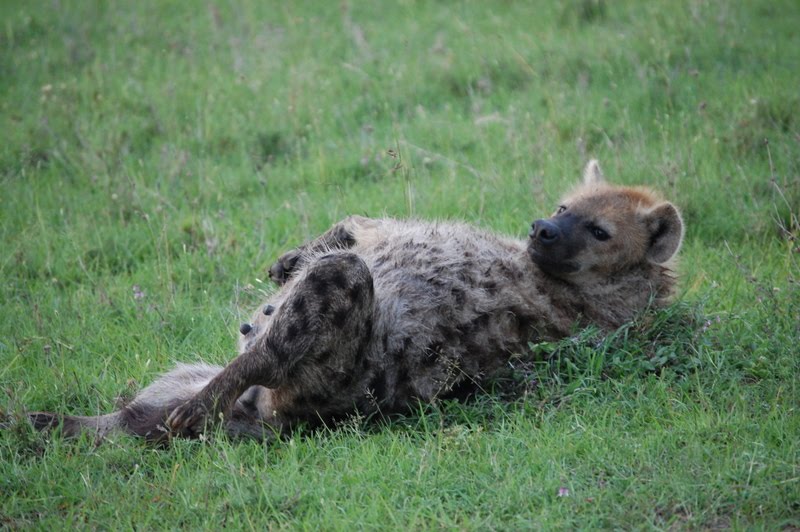
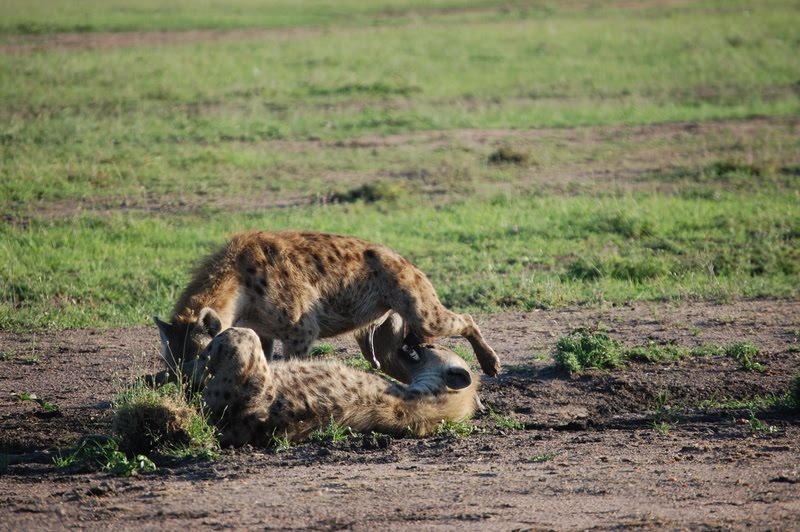
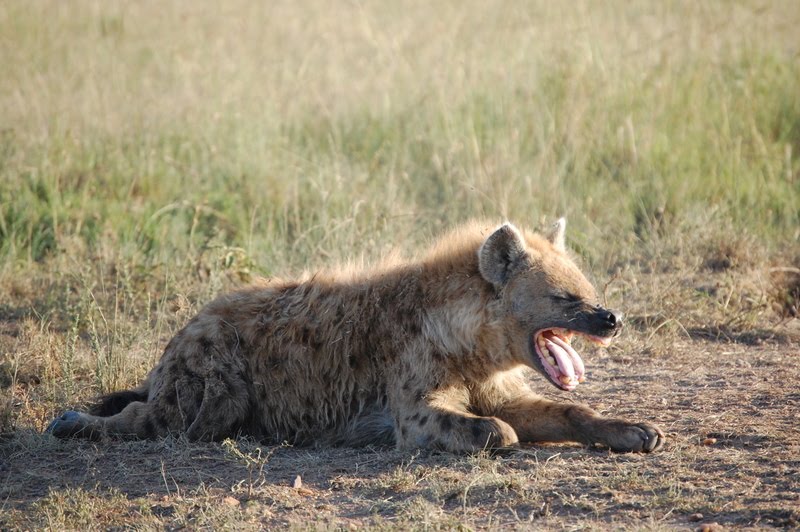
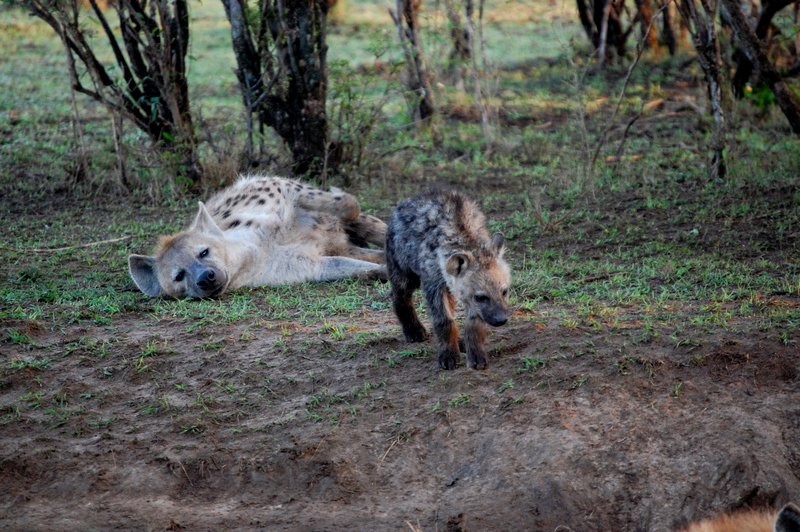
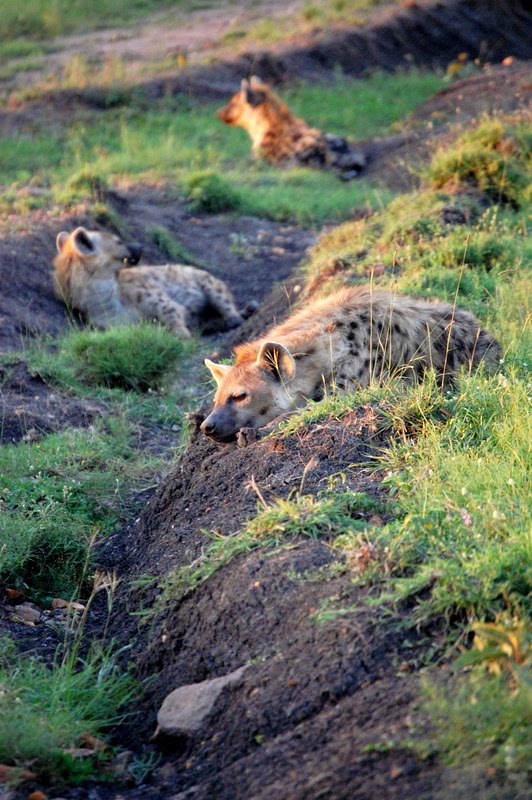
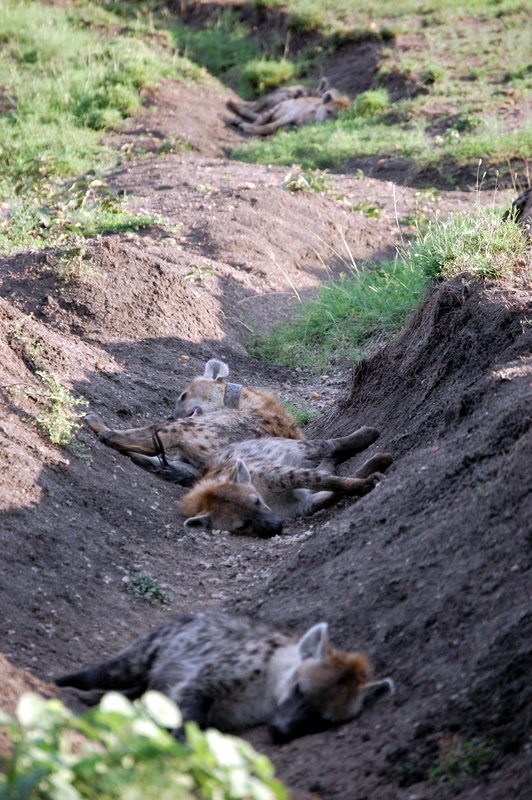
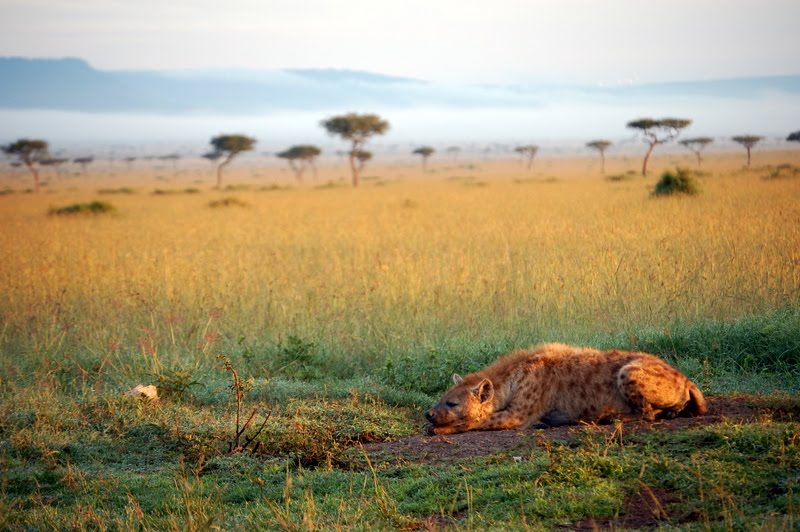
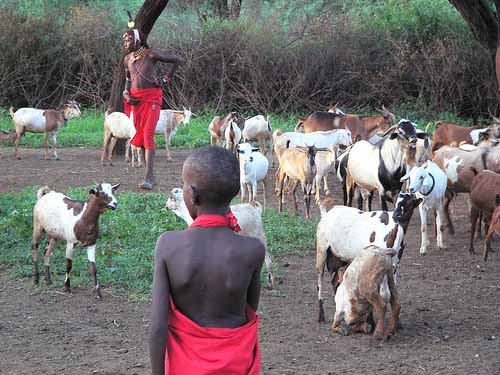
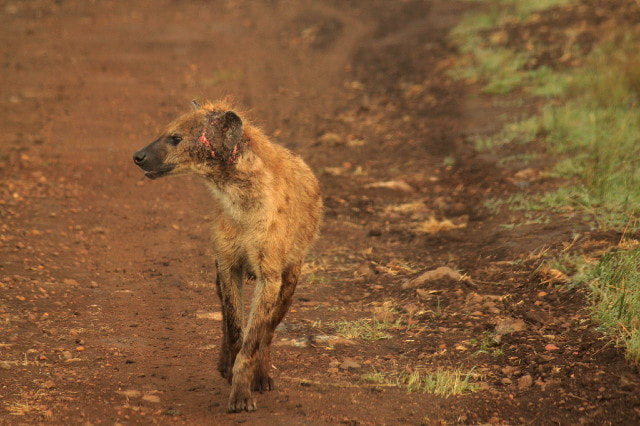
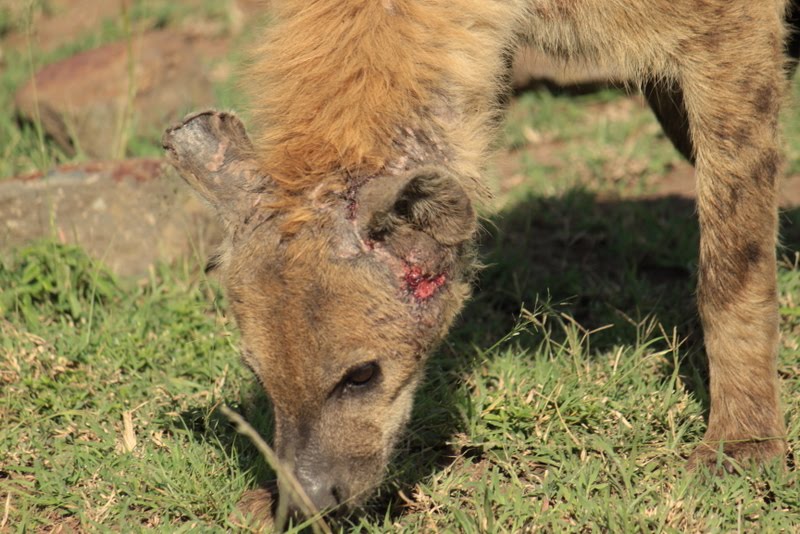
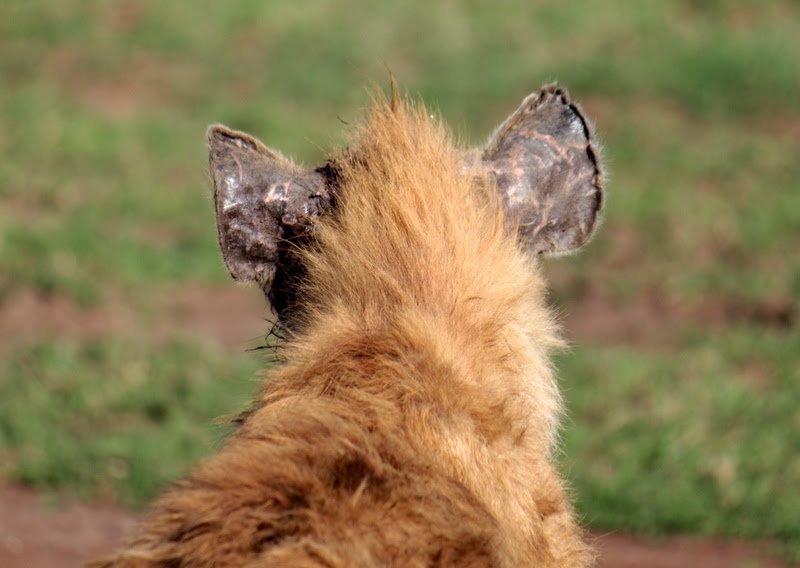
 RSS Feed
RSS Feed